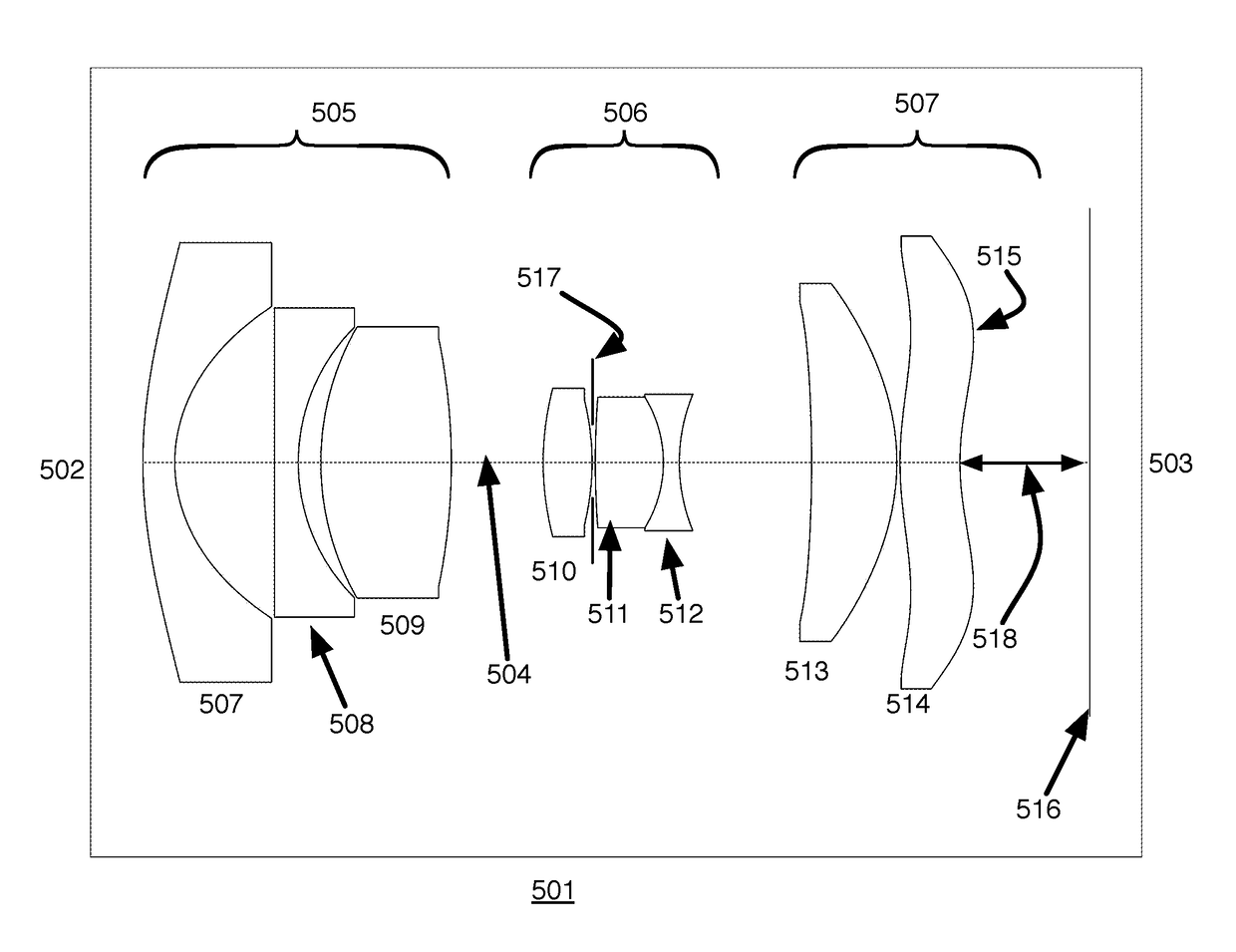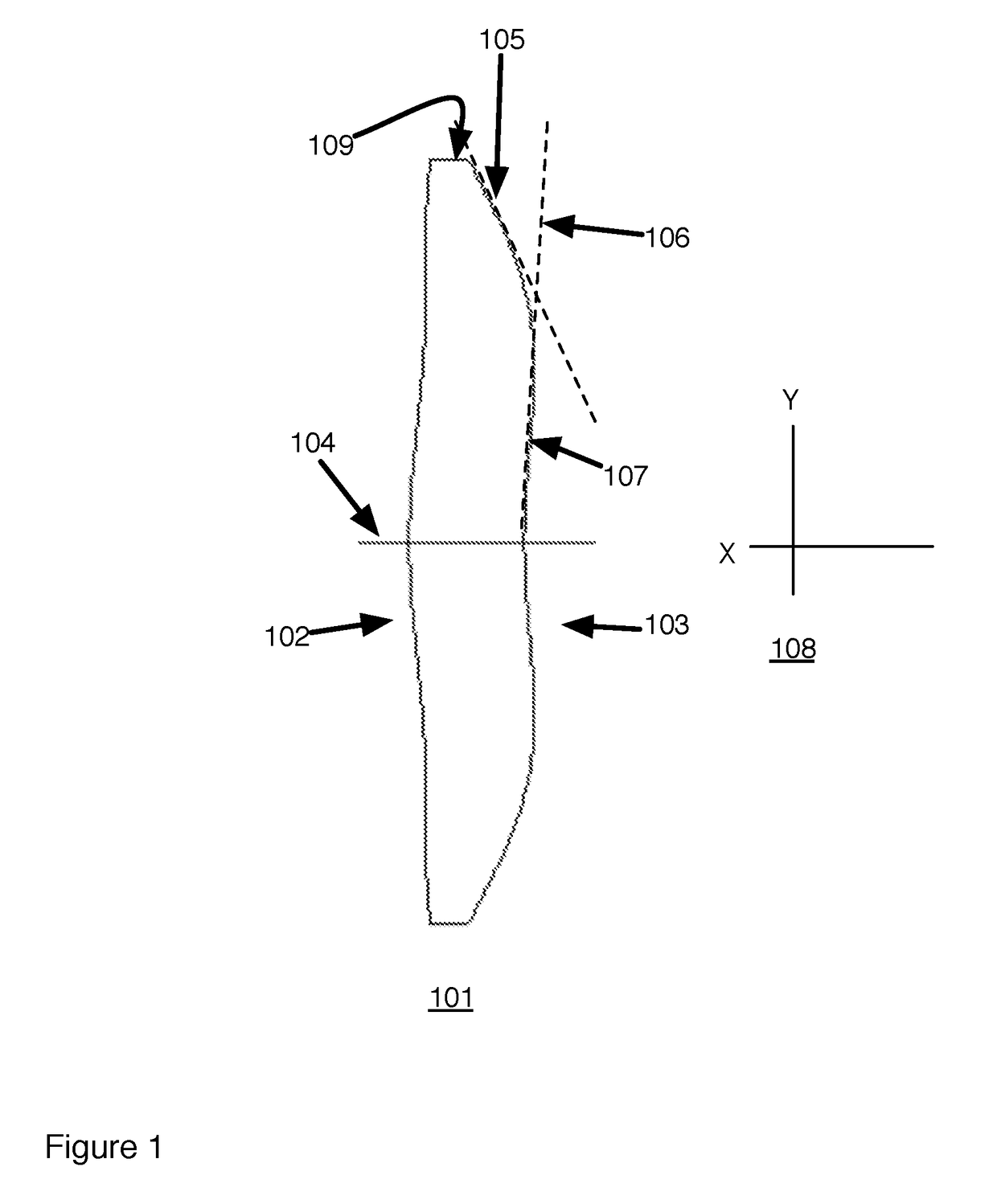Compact Wide Angle Lens
a wide-angle lens, compact technology, applied in the field of wide-angle lenses, can solve the problems of incongruity of image feature detail location across the image plane, affecting the proper functioning of intended application, and affecting the accuracy of wide-angle lenses,
- Summary
- Abstract
- Description
- Claims
- Application Information
AI Technical Summary
Benefits of technology
Problems solved by technology
Method used
Image
Examples
example 1
[0032]FIG. 2 shows the layout of Example 1. This design has a field angle of + / −47°, for a total field of view 94°, with a relative aperture of F / 2.8. The lens is comprised, from object to image, of three lens groups. Group 1, 205 comprises two lens elements 208, 209. Group 2, 206 comprises three lens elements 210, 211, 212 with an aperture stop between the first 210 and second 211 element of the group and the second and third elements 211, 212 of the group are a cemented doublet. Group 3 comprises two lens elements 213, 214 and are aspheric elements. All four surfaces of these two lens elements 213, 214 are aspheric The image space facing side 218 the last lens element 214 is a complex aspheric surface. Table 1A shows the optical specification for this first example. The surfaces are numbered as already described. The radiuses of curvature are measured at the optical axis 204. Table 1B shows the optical specifications for the aspheric lens by providing the constants for Equation 1....
example 2
[0033]FIG. 3 shows the layout of Example 2. This design has a field angle of + / −50° (for a total field of view)100° with a relative aperture of F / 2.8. The lens 301, in going from object 302 to image 303, is comprised of three (3) lens groups 305, 306, 307. The first lens group 305 has negative power and is comprised of at least 2 lens elements and in this example is comprised of three lens elements 307, 308, 309. At least one of the elements 309 is a positive lens element. An aspheric element 308 is included in this first group 305.
[0034]The second lens group 306 has positive power comprising at least 3 lens elements 310, 311, 312 including a cemented doublet formed by two of the 3 elements 311, 312, and an aperture stop 317. The first 310 and the second 311 elements have positive power. The third element 312 has negative power having a double concave shape. The 2nd and 3rd elements 311, 312 form a cemented doublet. An aperture stop 317 is located between the first 310 and second 31...
example 3
[0036]FIG. 4 shows the layout of Example 3. This design has a field angle of + / −45° (for a total field of view)90° with a relative aperture of F / 2.9. The lens 401, in going from object 402 to image 403, is comprised of three (3) lens groups 405, 406, 407. The first lens group 405 has negative power and is comprised of at least 2 lens elements and in this example is comprised of three lens elements 407, 408, 409. At least one of the elements 409 is a positive lens element. An aspheric element 407 is included in this first group 405.
[0037]The second lens group 406 has positive power comprising at least 3 lens elements 410, 411, 412 including a cemented doublet formed by two of the 3 elements 411, 412, and an aperture stop 417. The first 410 and the second 411 elements have positive power. The third element 412 has negative power having a double concave shape. The 2nd and 3rd elements 411, 412 form a cemented doublet. An aperture stop 417 is located between the first 410 and second 411...
PUM
 Login to View More
Login to View More Abstract
Description
Claims
Application Information
 Login to View More
Login to View More - R&D
- Intellectual Property
- Life Sciences
- Materials
- Tech Scout
- Unparalleled Data Quality
- Higher Quality Content
- 60% Fewer Hallucinations
Browse by: Latest US Patents, China's latest patents, Technical Efficacy Thesaurus, Application Domain, Technology Topic, Popular Technical Reports.
© 2025 PatSnap. All rights reserved.Legal|Privacy policy|Modern Slavery Act Transparency Statement|Sitemap|About US| Contact US: help@patsnap.com



